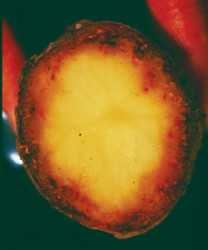Potato Pointers: Blight 2009: A Visit From An Old Familar Enemy


This photo shows a cross section of potato tuber with late blight infection. Note the red-brown, dry, granular, appearance of the infected tissues.
Still the most important disease of potatoes on a worldwide basis, late blight (caused by Phytophthora infestans) continues to make headlines, this time with a massive outbreak in the potato and tomato crops of the Northeast during the summer of 2009. By now, late blight has been responsible for some pretty serious yield losses in both crops in this production area. However, just because the season is ending doesn’t mean that our troubles are over — this disease can be every bit as devastating in storage as it is in the field.
Late blight travels on the wind within infected fields and from field to field. The reproductive structures of this organism are called “sporangia (singular sporangium)” and they are produced in huge numbers within the infected tissues of the foliage. These same structures can fall downwards and come into contact with tubers through cracks in the soil. Tubers can also be exposed to the sporangia when they are mixed with green foliar tissues that contain the live fungus during harvesting and handling.
Watch Out For Rot
Storage problems occur by the direct action of the late blight disease in the tubers and also by providing an entry point into the tuber for other storage diseases. Late blight tuber lesions can be readily infected by pink rot, pythium (leak), and bacterial soft rot. Soft rot can be particularly devastating in storage as the bacterium is capable of causing problems with or without the presence of oxygen. The increased respiration due to the disease also creates heat. Rapid “melt down” of an entire crop in storage is often the result.
Tuber tissues infected with late blight have a reddish-brown, granular appearance (see photo). In spite of the fact that this disease is intimately associated with wet conditions, the rot caused by pure late blight infection is actually a dry rot. As outlined above, however, the rotted tissues can readily become wet if the damaged tissues are invaded by leak or bacterial soft rot.
Risk Factors
Management of late blight in storage begins with management of the disease in the foliage in the field. By minimizing the amount of blight in foliage, it is possible to minimize the exposure of tubers to the disease.
Another recommendation is to ensure that the vines are totally dead before attempting to harvest. If late blight has an Achilles’ heel, it is that the organism can only be maintained in living host tissues and dies along with the infected host. The sporangia, as good as they are at spreading the disease, are generally not very long-lived either, with an effective lifetime probably measured in hours.
Fields known to be infected with late blight are at risk for storage rot problems. One option is to treat tubers with phosphorus acid (unfortunately this product is not labeled for organic production) as the potatoes are loaded into the storage. Phosphorus acid treatment has been shown to reduce incidence and severity of late blight infection in tubers challenged with the late blight organism.
If the disease is brought into the storage, remember that the three tools of the storage manager are temperature, humidity, and airflow. These can be used in combination to minimize problems with stored potatoes. A small amount of late blight tuber infection, perhaps 1% or 2%, can probably be safely stored, but the potatoes will need to be monitored carefully. In some cases, early marketing may be the best approach to retain the value of the crop.
Growers in the affected areas of the U.S. can breathe a sigh of relief that they’ve gotten through one of the worst outbreaks of late blight in recent history. Unfortunately, the widespread nature of this year’s outbreak means that late blight is likely to successfully overwinter in these same areas and could also get an early start next year. If the weather is as favorable next year as it was this year, growers could be in for another wild ride. On the plus side, preventive measures that can protect your crop from infection can be taken when the risk of disease is known to be high.










